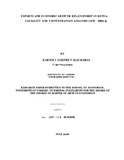| dc.description.abstract | The relationship between exports and economic growth has been analysed for a long period.
Whether exports expansion cause economic gains or losses, whether economic growth causes
exports expansion or reduction, and whether a feedback relationship exists between exports growth
and economic growth has been a recurring empirical problem. Empirical evidence linking exports to
economic growth has been mixed and inconclusive due to fundamental differences in methodology,
analytical techniques, sample period and study countries.
This study examines the exports-growth relationship in Kenya using secondary annual time series
data for 1970 - 2004. Particularly, the study investigates export-led growth hypothesis for Kenya by
testing for Granger causality between exports growth and economic growth. The study also
investigates the long-run nature of the export-growth relationship by applying cointegration analysis
and error correction mechanism to estimate an augmented simple production function using
ordinary least squares method. Inclusion of exports and imports provides an alternative procedure to
capture total factor productivity growth. By considering relevant variables omitted in previous
studies for Kenya and by covering both imports-substitution and export-promotion eras, including
trade liberalization period, help clarify and improve past empirical results and minimizes the
existing knowledge gap. The results of this study indicate that there is unidirectional causality from exports growth to
economic growth and by disaggregating exports into primary and manufactured exports; the
unidirectional causality is from primary exports to economic growth. There is a significant long-run
relationship between economic growth, exports, imports and capital formation. The study further
reveals significant long-run positive impact of exports, particularly primary exports on economic
growth while manufactured exports' impact, though positive is insignificant. On the other hand, the
short-run effects of both primary and manufactured exports are negative. Considering that Kenya
has been experiencing low, slow and unstable economic growth, coupled with rising poverty and
unemployment levels, this study concludes that primary exports-led growth is undesirable for
economic development. Therefore, primary exports should not be relied upon further as "engine of
growth", since this is unfavourable to Kenya's economic prosperity. Instead, more resources should
be directed towards value-addition of primary exports and growth and competitiveness of
manufactured exports. | en |

